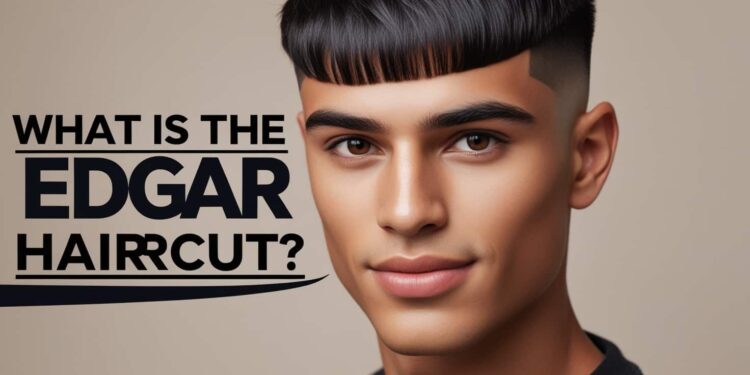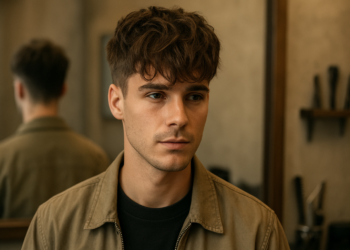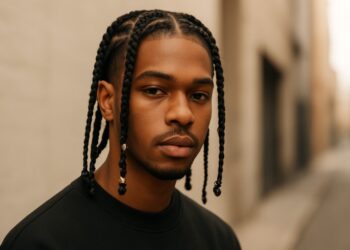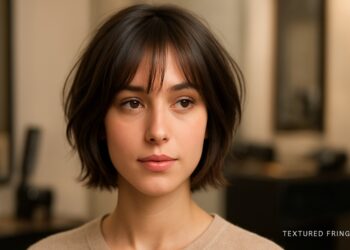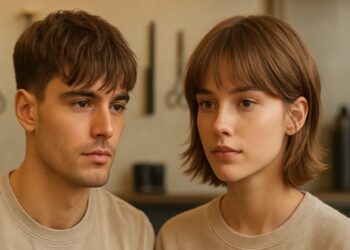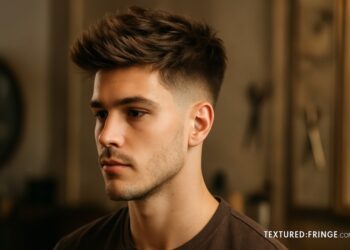The Edgar haircut is a modern men’s style featuring a short, straight-across fringe (bangs) on top and a high fade or taper on the sides. Think of it as a sharper, more defined bowl cut – one barber describes it as “a high taper fade with a blunt cropped fringe”. In practice, the hair on the front hangs down evenly above the forehead (like a little shelf), while the back and sides are closely cut or faded. This bold look has deep Latino cultural roots but has exploded in popularity across Gen Z and Millennials in the U.S.
- High-Fade & Fringe: The Edgar is essentially a crisp bowl cut plus a skin- or taper-fade on the sides.
- Gen Z Latino Trend: It “has struck a chord with Gen Z Latinos and late millennials,” one report notes. In Los Angeles schools, teachers even say their classes are “swarmed by Edgars”.
- Origins: It likely traces back to indigenous styles (the Jumano tribe of early Texas) and Mexican-American “Takuache” culture. The name “Edgar” itself may come from legends about baseball player Edgar Martínez popularizing it.
- Variations: Barbers tweak the basic cut in many ways – from a gentle taper fade to a “fluffy” top – so no two Edgars look exactly alike. (More on variations below.)
- Meme Status: It’s become an internet meme, often paired with jokes like “Lord Edgar” or “boss levels”, and even faced humorous bans in schools.
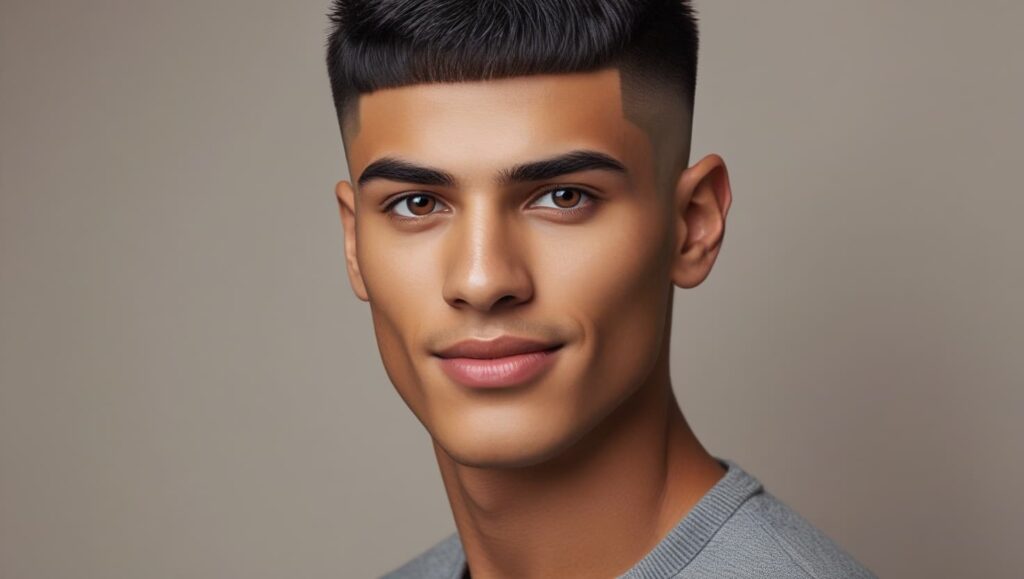
What Is the Edgar Haircut?
The Edgar cut is a bold, short haircut where the top hair is cropped straight across just above or at the forehead, and the sides/back are sharply faded or tapered. In other words, imagine a bowl cut lifted by clipper work. The defining feature is that straight-across “mustache” of hair on the forehead, contrasting with tightly cut sides. It can be worn on any hair texture – straight, wavy or even curly – since barbers simply bring the hair forward from any natural curl. In fact, stylists often dry the hair forward (sometimes with a diffuser) to emphasize the fringe, then use a matte paste or light gel for hold.
“The Edgar cut is one of many modern varieties of the French crop,” notes one UK barber, “combining a high taper fade with a blunt cropped fringe”. That means it is like a Caesar cut or French crop on steroids: the fade usually sits higher up the scalp, creating a stark contrast between top and sides. If the top is left longer, it can even resemble a classic bowl cut, but with modern texture or “choppiness” added.
Origins & Cultural Roots
The Edgar haircut has Latin American and Mexican-American roots. Hairstyle historians and local media trace its lineage to the Jumano Indigenous tribes of early Texas/Mexico (1500s–1700s). For example, We Are Mitú reports that Jumano men wore a similar short hairstyle, and that later “their haircut survived in what we now call the Edgar.”. It re-emerged in Mexican-American communities, where young men calling themselves “takuaches” (a slang for truck-driving Latino youth) sported a high fade plus bangs. Indeed, the Mexican media often refer to it as the Takuache haircut.
The name “Edgar” itself is more mysterious. Some believe it’s an homage to MLB star Edgar Martínez – a viral barbershop story claims a fan once asked a barber to shave his face on the back of his head in tribute to the player. Whatever the truth, by the late 2010s the style was widely known online as the Edgar cut. One barbershop blogger jokes that until recently, only kids nicknamed Edgar ever wore it – a self-fulfilling joke as the name stuck in meme culture.
Why It’s Trending in the USA
Originally a Southwest U.S. phenomenon, the Edgar became a regional staple in border states like Texas, New Mexico, Arizona and California. Local barbers shaved countless kids’ hair with that straight line, and word spread. But social media really fueled the trend nationwide. TikTok videos and Instagram hashtags (#EdgarCut, #Takuache, #LordEdgar) helped the look reach coast to coast. For example, NBC News notes the style has “struck a chord with Gen Z Latinos and late millennials” in the U.S., and a Dallas barber said he does “at least seven Edgar haircuts a day” – even for 5th graders!
As one writer observes, the Edgar “is a massively popular style worn by Latine youth” in places like California. Even outside big cities, photos of Hispanic teens with this cut are everywhere on social media. It’s not really illegal in any way, but it has inspired some tongue-in-cheek controversy. (More on that below.) In short, if you walk down many school hallways in Texas or SoCal today, chances are high you’ll see an Edgar walking the other way.
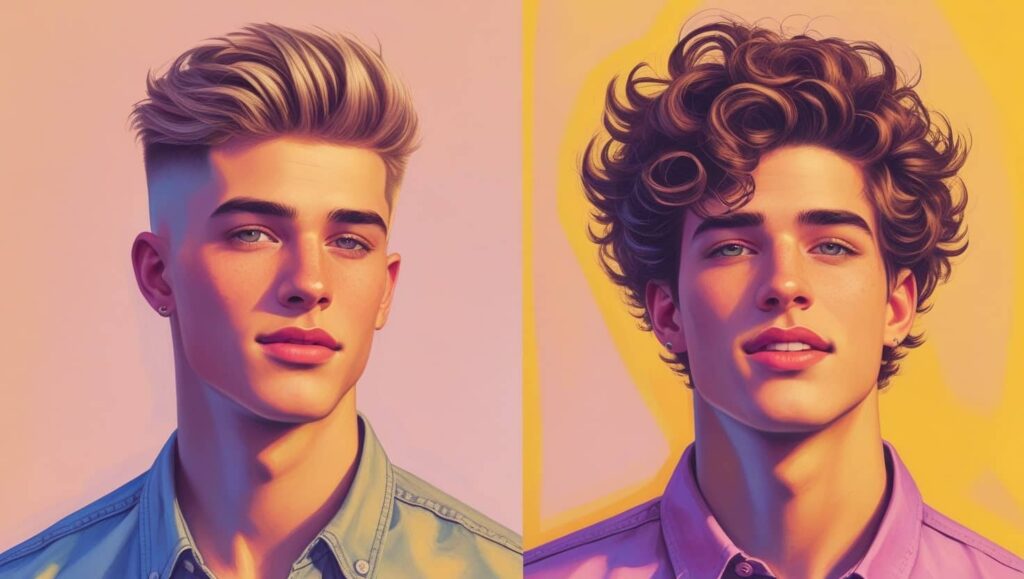
Popular Variations: Taper, Fluffy, Curly, etc.
Barbers and clients get creative with the Edgar. The basic structure (fringe + fade) remains, but you’ll find many twists:
- Classic Edgar: Short crop on top with a straight-across fringe and a high skin fade on the sides. This is the “textbook” look: neat, sharp, and exactly at forehead level.
- Taper Fade Edgar: Instead of a bald fade, some men opt for a gradual taper that blends the side hair into the top. It softens the look. (“Just ask for a high or mid taper fade Edgar,” many stylists say, which means the cut side gradually from shorter to longer.)
- Fluffy Edgar: More length is left on top and styled upward or messily for volume. It still has the straight fringe, but the hair has layers or texture so it looks “fluffier” on top. Often a styling product (like sea salt spray or light pomade) is used to lift the hair. Some barbers call this a “messy Edgar” or “fluffy crop.”
- Curly Edgar: Men with wavy or curly hair can still get an Edgar. The cut is done similarly, but the natural waves fall forward. The stylists at Textured Fringe often wet-set the top and use a diffuser: the curls come down into that blunt fringe. so it works for curls too.
- Takuache/Edgar+Design: In Mexican-American takuache culture, the Edgar might be spiced up with shaved lines, patterns, or even color fades. (Think of a Chevy truck with racing stripes, but on your head.) These clients embrace extra flair that matches the “Takuache” aesthetic of flashy trucks and boots.
Each of these still delivers the core effect: defined front bangs and faded sides. The difference is only in how much hair is left on top and how the fade is done. Feel free to show your barber a photo (maybe from our [site] or social media) – pictures say it best.
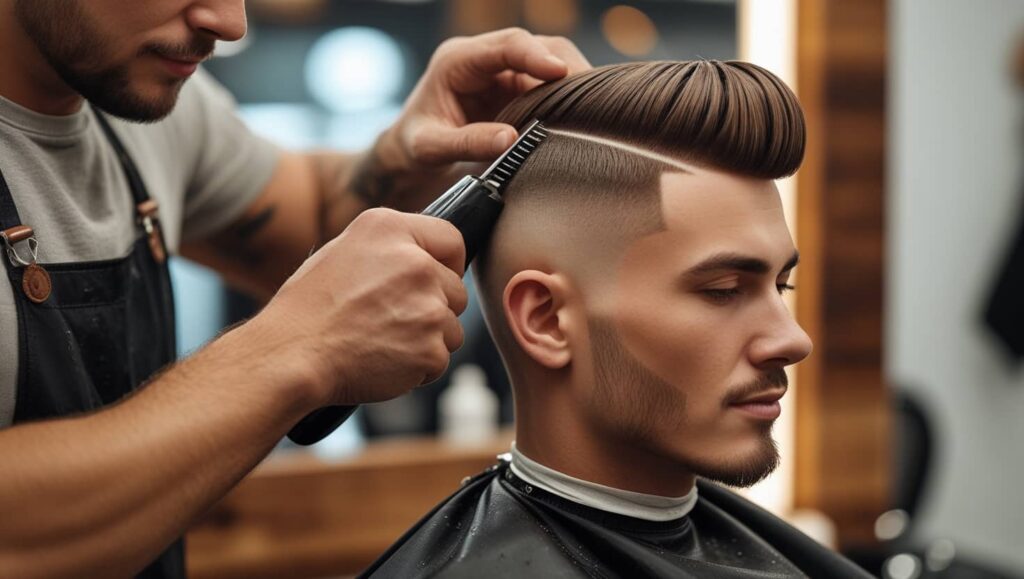
Meme & Pop-Culture Buzz
No trendy cut stays under the radar in the internet age, and the Edgar is no exception. It quickly became fodder for jokes and memes. Social media loves it: on TikTok and Instagram you’ll see thousands of #EdgarCut posts and playful tags like #LordEdgar or #cuh (short for cousin, Mexican slang). One viral TikTok quipped “You’ve reached the final level to the big boss, LORD EDGAR” – treating the haircut like a video game boss battle. Even Texan teens walking behind an Edgar are a meme, as creators jokingly “chase” the haircut with music.
In 2019 alone, Twitter lit up with Edgar humor. For instance, a popular tweet joked: “After you’ve defeated all the Edgars and Joses you must face these 2” (accompanied by an image) – racking up tens of thousands of likes. By 2021–22, dozens of Edgar-themed TikToks were making the rounds: people would dance or narrate funny skits featuring the cut.
Despite some mockery, many fans wear the style with pride. In fact, early on some adults tried to ban it as a “distraction.” A 2021 petition in an El Paso, TX high school hilariously called to forbid “Edgar Cuts,” claiming they had “detrimental effects” on education. A bar owner in San Antonio also stirred controversy by banning Edgars from his shop. (Needless to say, that ban did not stick – Edgars still roam free!) Today, many Latinos see it as a statement of identity and even a throwback to childhood “home cuts” done by mom. As one writer puts it, the style has flipped from being a source of derision to a “symbol of pride” for many.
How to Get (or Update) an Edgar Cut
Thinking of trying it? We’re all for it at Textured Fringe – it’s a surefire conversation starter! When you head to the barber, just say “I want an Edgar cut” and maybe show a picture. Barbers will know: they’ll typically use clippers to taper (or fade) your sides up high, then trim the front so the top hair sits in a straight line. A classic instruction is “high skin fade with a hard line-up and short bangs.”
Styling is mostly maintenance. To keep it sharp, ask your barber for a lineup around the forehead (the straight edge) and regular trims. Some people push the fringe forward onto the forehead for a bit of length; others take it right up to the brow. If your hair is curly or thick, drying it forward and applying pomade can help it lay flat. Don’t overthink it – part of the Edgar’s charm is its DIY vibe (many people cut it themselves at home, too!).
At home, use a small comb or your fingers to position the fringe straight down. A matte clay or wax helps define the lines. For a “fluffy” spin, massage a volumizing powder or light gel at the roots. The sides need little work beyond routine fades. (Honestly, the hairstyle will look fine as it grows out for a week – it’s already pretty lived-in by nature!) We find younger clients love adding a little quirky detail, like a line design or subtle undercut transition, but that’s totally optional.
FAQs
What exactly is an Edgar haircut?
It’s a short men’s cut with a straight fringe across the forehead and faded (or tapered) sides and back. Imagine a bowl cut blended into a high fade.
How did it get the name “Edgar”?
The origin is unclear. One story links it to baseball player Edgar Martínez (a fan once got a design of his face on the back of his head). Others say it was just a slang name from social media. The haircut itself predates the name.
Why is it often called the Mexican or Takuache haircut?
Because it became famous among young Mexican-American men, especially those called “takuaches” (a slang for truck-loving Latino teens). The style matches that aesthetic. Still, anyone can wear it – it’s not limited to one group.
Can I get an Edgar haircut if my hair is curly or fine?
Yes! Barbers say it “can be worn with any hair texture”. Curly-haired guys often get a shorter bang and use product to keep the curls in place. Fine hair also works because the strong fade and line-up do most of the visual work.
What’s a “fluffy Edgar” haircut?
That’s just a casual term for leaving extra length/layers on top so the hair is more voluminous or messy. It still has the straight-across fringe, but the top is styled to look full rather than flat. A barber might blow-dry the top upward or use sea salt spray to achieve this.
Is the Edgar cut still popular in 2025?
Absolutely – it’s had huge staying power. While not every guy will rock it, it remains a staple request, especially in salons near Latino communities. In fact, at our salon at Textured Fringe we see new variations of it all the time.
Why was it sometimes “banned” or criticized?
Early on, some adults saw the extreme look (and its associations with youth culture) as distracting or even “gangster.” This led to jokes about school bans. Today most critics have moved on – many now appreciate it as a cultural style or just a fun trend.
Overall, the Edgar haircut is more than just a haircut; it’s a cultural phenomenon blending nostalgia, identity, and style. Its rise has been fueled by social media and youth culture, but at heart it’s a simple, attention-grabbing cut. At Textured Fringe, we encourage anyone curious to give it a try (or at least admire it) – whether straight, wavy, or wildly curly hair, there’s an Edgar for you.
